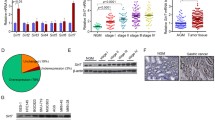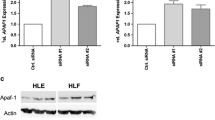Abstract
During cancer development, tumor suppressor genes were silenced by promoter methylation or histone deacetylation. Histone deacetylases (HDACs) are important to maintain histone deacetylation. HDAC inhibitors (HDACis) were thus proposed as a new therapeutic approach to cancer. The current study aims to understand the effect and molecular mechanisms of HDACis on gastric cancer cells. Trichostatin A (TSA) significantly inhibited the growth of gastric cancer cells by inducing apoptosis. Gene profiling results showed PUMA (p53 upregulated modulator of apoptosis) as one of 122 genes upregulated in TSA-treated gastric cancer cells. PUMA was downregulated in gastric cancer cell lines and primary gastric carcinoma tissues. Patients with low PUMA expression had significant decreases in overall survival (HR, 2.04; p = 0.047). Ectopic PUMA expression inhibited the growth of gastric cancer cells while PUMA depletion promoted cellular growth. The knockdown of HDAC3 but not other HDACs upregulated PUMA expression. HDAC3 could bind to PUMA promoter, which was abrogated after TSA treatment. In contrast to TSA and SB, HDAC3 siRNA failed to upregulate p53 expression but promoted the interaction of p53 with PUMA promoter. In summary, proapoptotic PUMA was downregulated in gastric cancer and its mRNA expression level is a valuable prognosis factor for gastric cancer. HDAC3 is important to downregulate PUMA expression in gastric cancer and HDACis, like TSA, promoted PUMA expression through stabilizing p53 in addition to HDAC3 inhibition. In combination with chemotherapy, targeting HDAC3 might be a promising strategy to induce apoptosis of gastric cancer cells.






Similar content being viewed by others
References
Ushijima T, Sasako M (2004) Focus on gastric cancer. Cancer Cell 5:121–125
Esteller M (2008) Epigenetics in cancer. N Engl J Med 358:1148–1159
Gal-Yam EN, Saito Y, Egger G, Jones PA (2008) Cancer epigenetics: modifications, screening, and therapy. Annu Rev Med 59:267–280
Ooi SL, Henikoff S (2007) Germline histone dynamics and epigenetics. Curr Opin Cell Biol 19:257–265
Jenuwein T, Allis CD (2001) Translating the histone code. Science 293:1074–1080. doi:10.1126/science.1063127
Marks P, Rifkind RA, Richon VM, Breslow R, Miller T, Kelly WK (2001) Histone deacetylases and cancer: causes and therapies. Nat Rev Cancer 1:194–202. doi:10.1038/35106079
Momparler RL (2003) Cancer epigenetics. Oncogene 22:6479–6483. doi:10.1038/sj.onc.1206774
Mariadason JM (2008) HDACs and HDAC inhibitors in colon cancer. Epigenetics 3:28–37
Itoh Y, Suzuki T, Miyata N (2008) Isoform-selective histone deacetylase inhibitors. Curr Pharm Des 14:529–544
Kim HJ, Bae SC (2011) Histone deacetylase inhibitors: molecular mechanisms of action and clinical trials as anti-cancer drugs. Am J Transl Res 3:166–179
Lane AA, Chabner BA (2009) Histone deacetylase inhibitors in cancer therapy. J Clin Oncol 27:5459–5468. doi:10.1200/JCO.2009.22.1291
Bots M, Johnstone RW (2009) Rational combinations using HDAC inhibitors. Clin Cancer Res 15:3970–3977. doi:10.1158/1078-0432.CCR-08-2786
Zhang X, Yashiro M, Ren J, Hirakawa K (2006) Histone deacetylase inhibitor, trichostatin A, increases the chemosensitivity of anticancer drugs in gastric cancer cell lines. Oncol Rep 16:563–568
Hebbel RP, Vercellotti GM, Pace BS, Solovey AN, Kollander R, Abanonu CF, Nguyen J, Vineyard JV, Belcher JD, Abdulla F et al (2010) The HDAC inhibitors trichostatin A and suberoylanilide hydroxamic acid exhibit multiple modalities of benefit for the vascular pathobiology of sickle transgenic mice. Blood 115:2483–2490. doi:10.1182/blood-2009-02-204990
Park H, Lee YJ, Kim TH, Lee J, Yoon S, Choi WS, Myung CS, Kim HS (2008) Effects of trichostatin A, a histone deacetylase inhibitor, on the regulation of apoptosis in H-ras-transformed breast epithelial cells. Int J Mol Med 22:605–611
Yu J, Zhang L, Hwang PM, Kinzler KW, Vogelstein B (2001) PUMA induces the rapid apoptosis of colorectal cancer cells. Mol Cell 7:673–682
Jeffers JR, Parganas E, Lee Y, Yang C, Wang J, Brennan J, MacLean KH, Han J, Chittenden T, Ihle JN et al (2003) Puma is an essential mediator of p53-dependent and -independent apoptotic pathways. Cancer Cell 4:321–328
Villunger A, Michalak EM, Coultas L, Mullauer F, Bock G, Ausserlechner MJ, Adams JM, Strasser A (2003) p53- and drug-induced apoptotic responses mediated by BH3-only proteins puma and noxa. Science 302:1036–1038. doi:10.1126/science.1090072
Wu B, Qiu W, Wang P, Yu H, Cheng T, Zambetti GP, Zhang L, Yu J (2007) p53 independent induction of PUMA mediates intestinal apoptosis in response to ischaemia-reperfusion. Gut 56:645–654. doi:10.1136/gut.2006.101683
Liu D, Ou L, Clemenson GD Jr, Chao C, Lutske ME, Zambetti GP, Gage FH, Xu Y (2010) Puma is required for p53-induced depletion of adult stem cells. Nat Cell Biol 12:993–998. doi:10.1038/ncb2100
Chen X, Leung SY, Yuen ST, Chu KM, Ji J, Li R, Chan AS, Law S, Troyanskaya OG, Wong J et al (2003) Variation in gene expression patterns in human gastric cancers. Mol Biol Cell 14:3208–3215. doi:10.1091/mbc.E02-12-0833
Chipuk JE, Bouchier-Hayes L, Kuwana T, Newmeyer DD, Green DR (2005) PUMA couples the nuclear and cytoplasmic proapoptotic function of p53. Science 309:1732–1735. doi:10.1126/science.1114297
Roy S, Packman K, Jeffrey R, Tenniswood M (2005) Histone deacetylase inhibitors differentially stabilize acetylated p53 and induce cell cycle arrest or apoptosis in prostate cancer cells. Cell Death Differ 12:482–491. doi:10.1038/sj.cdd.4401581
Tang Y, Zhao W, Chen Y, Zhao Y, Gu W (2008) Acetylation is indispensable for p53 activation. Cell 133:612–626. doi:10.1016/j.cell.2008.03.025
Obata T, Toyota M, Satoh A, Sasaki Y, Ogi K, Akino K, Suzuki H, Murai M, Kikuchi T, Mita H et al (2003) Identification of HRK as a target of epigenetic inactivation in colorectal and gastric cancer. Clin Cancer Res 9:6410–6418
Gao J, Senthil M, Ren B, Yan J, Xing Q, Yu J, Zhang L, Yim JH (2010) IRF-1 transcriptionally upregulates PUMA, which mediates the mitochondrial apoptotic pathway in IRF-1-induced apoptosis in cancer cells. Cell Death Differ 17:699–709. doi:10.1038/cdd.2009.156
Acknowledgments
This work was supported by Program for Innovative Research Team in Zhejiang Province (no. 2012R10046-15), Research Projects of Zhejiang Education Department (no.Y201121548), and Program for Qianjiang Scholarship in Zhejiang Province (2011R10061) to HJ. We thank Dr. Jennifer Holder Monaghan and Mr. Richard Anderson for the English editing.
Competing interests
We have no conflict of interest to claim.
Author information
Authors and Affiliations
Corresponding authors
Electronic supplementary material
Below is the link to the electronic supplementary material.
ESM 1
(PDF 1059 kb)
Rights and permissions
About this article
Cite this article
Feng, L., Pan, M., Sun, J. et al. Histone deacetylase 3 inhibits expression of PUMA in gastric cancer cells. J Mol Med 91, 49–58 (2013). https://doi.org/10.1007/s00109-012-0932-x
Received:
Revised:
Accepted:
Published:
Issue Date:
DOI: https://doi.org/10.1007/s00109-012-0932-x




